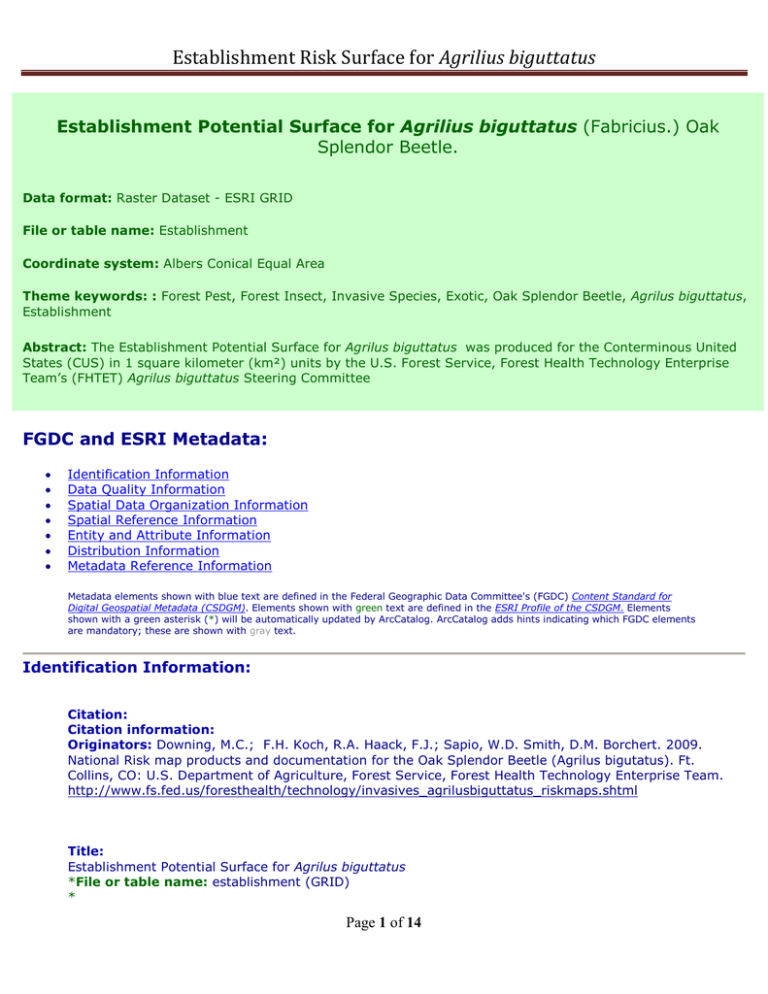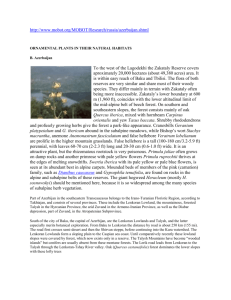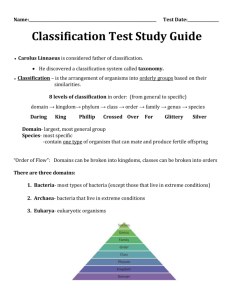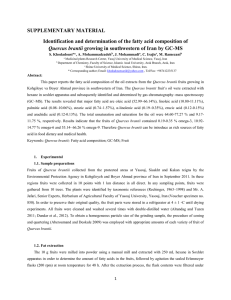Agrilius biguttatus Splendor Beetle.
advertisement

Establishment Risk Surface for Agrilius biguttatus Establishment Potential Surface for Agrilius biguttatus (Fabricius.) Oak Splendor Beetle. Data format: Raster Dataset - ESRI GRID File or table name: Establishment Coordinate system: Albers Conical Equal Area Theme keywords: : Forest Pest, Forest Insect, Invasive Species, Exotic, Oak Splendor Beetle, Agrilus biguttatus, Establishment Abstract: The Establishment Potential Surface for Agrilus biguttatus was produced for the Conterminous United States (CUS) in 1 square kilometer (km²) units by the U.S. Forest Service, Forest Health Technology Enterprise Team’s (FHTET) Agrilus biguttatus Steering Committee FGDC and ESRI Metadata: • • • • • • • Identification Information Data Quality Information Spatial Data Organization Information Spatial Reference Information Entity and Attribute Information Distribution Information Metadata Reference Information Metadata elements shown with blue text are defined in the Federal Geographic Data Committee's (FGDC) Content Standard for Digital Geospatial Metadata (CSDGM). Elements shown with green text are defined in the ESRI Profile of the CSDGM. Elements shown with a green asterisk (*) will be automatically updated by ArcCatalog. ArcCatalog adds hints indicating which FGDC elements are mandatory; these are shown with gray text. Identification Information: Citation: Citation information: Originators: Downing, M.C.; F.H. Koch, R.A. Haack, F.J.; Sapio, W.D. Smith, D.M. Borchert. 2009. National Risk map products and documentation for the Oak Splendor Beetle (Agrilus bigutatus). Ft. Collins, CO: U.S. Department of Agriculture, Forest Service, Forest Health Technology Enterprise Team. http://www.fs.fed.us/foresthealth/technology/invasives_agrilusbiguttatus_riskmaps.shtml Title: Establishment Potential Surface for Agrilus biguttatus *File or table name: establishment (GRID) * Page 1 of 14 Establishment Risk Surface for Agrilius biguttatus Publication date: 20100309 *Geospatial data presentation form: raster digital data Series information: Series name: Version 2.0 Issue identification: 20100309 Publication information: Publication place: Fort Collins, Colorado Publisher: Marla C. Downing Online linkage: http://www.fs.fed.us/foresthealth/technology/invasives_agriliusbiguttatus_riskmaps.shtml Larger work citation: Citation information: Originators: Downing, M.C.; F.H. Koch, R.A. Haack, F.J.; Sapio, W.D. Smith, D.M. Borchert. 2009. National Risk map products and documentation for the Oak Splendor Beetle (Agrilus bigutatus). Ft. Collins, CO: U.S. Department of Agriculture, Forest Service, Forest Health Technology Enterprise Team. http://www.fs.fed.us/foresthealth/technology/invasives_agrilusbiguttatus_riskmaps.shtml Title: Establishment Potential Surface for Agrilus biguttatus Oak Splendor Beetle. Description: Abstract: The Establishment Potential Surface for Agrilus biguttatus was produced for the conterminous United States in 1 square kilometer (km²) units by the U.S. Forest Service (USFS), Forest Health Technology Enterprise Team’s (FHTET) Agrilus biguttatus Steering Committee; a multidisciplinary team with participation from USFS, Animal and Plant Health Inspection Service (APHIS), and North Carolina State University (NCSU). The Establishment component for A. biguttatus depicts where the pest could survive if it was introduced. If the pest is known to have already been introduced, it may be desirable to prioritize locations where the pest populations are most able to survive and may be expanding. In cases where it is unknown whether the pest has been introduced the Establishment Component should be used in conjunction with the Introduction component to develop a Susceptibility component for A. biguttatus. Supporting biological information was gathered from USDA Forest Service Research Station experts, scientific literature, and the Exotic Forest Pest (ExFor) website (North American Forest Commission, 2008) http://spfnic.fs.fed.us/exfor/data/pestreports.cfm?pestidval=154&langdisplay=english Page 2 of 14 Establishment Risk Surface for Agrilius biguttatus References North American Forest Commission Exotic Forest Pest Information System (NAFC-ExFor). 2008. Invasive Species information system for pests with potential to cause significant damage to North American forest resources. Available at: http://spfnic.fs.fed.us/exfor/data/pestreports.cfm?pestidval=154&langdisplay=english Purpose: The product’s intended use in conjunction with the Introduction Potential Surface is to develop a Susceptibility Potential Surface for A. biguttatus. Three datasets were used as parameters in the analysis to determine the risk of establishment A. biguttatus poses in areas where it could survive: 1. Natural Host (i.e. Quercus spp from FIA) (Appendix A) 2. Drought (from 2007 – 2009) (Appendix B) 3. Urban Forest Natural Host Source: USDA Forest Service, Forest Inventory and Analysis (FIA) program. Only species of oaks (Quercus spp) contained in the FIA were considered (Appendix A). The oak were used as a presence absence data input. That is, oak, size, trees/acre, and basal area were not considered. Drought Source: USDA Forest Service, Forest Health Technology Enterprise Team (FHTET) (Appendix B). Extreme late spring or early summer drought conditions from the years of 2007 – 2009 were considered. These data were partitioned into 4 classes: 0 = No drought conditions were observed for all three years, 3 = drought conditions occurred for one year in the three year time period, 6 = drought conditions occurred for two years in the three year time period, and 10 = drought conditions occurred for three years in the three year time period. Urban Forest Source: USDA Forest Service, Forest Health Technology Enterprise Team (FHTET). The National Land Classification Data (NLCD) types: 1) Deciduous Forest or, 2) Mixed Forest was used as our urban forest input subset type. These data were filtered by urban areas as described by the City Light data set (Imhoff et al. 1997). The urban forest subset cell values were calculated by summing up the total area, in percent, of the NLCD cell (native cell size of NLCD is 30 meters by 30 meters) occupied within a 1 Km2 grid cell. Next, the data were partitioning into ten integer classes (1 – 10) using Jenks’ Natural breaks. Process Natural Host was modified by the drought producing a Disturbed Natural Host data set that contains values of 1, 3, 6, and 10. The Urban Forest was combined with the Disturbed Natural Host via an overlay Page 3 of 14 Establishment Risk Surface for Agrilius biguttatus process. If Disturbed Natural Host was spatially coincident with Urban Forest the cell value was assigned to the Disturbed Natural Host data set. References Imhoff, M. L., W. T. Lawrence, C. D. Elvidge, T. Paul, E. Levine, M. V. Privalsky, and V. Brown. 1997. Using Nighttime DMSP/OLS Images of City Lights to Estimate the Impact of Urban Land Use on Soil Resources in the United States. REMOTE SENS. ENVIRON. 59:105–117. *Language of dataset: en Time period of content: Time period information: Single date/time: Calendar date: 20100309 Currentness reference: publication date Status: Progress: Planned Maintenance and update frequency: As needed Spatial domain: Bounding coordinates: *West bounding coordinate: -131.718010 *East bounding coordinate: -50.048796 *North bounding coordinate: 54.232833 *South bounding coordinate: 17.231111 Local bounding coordinates: *Left bounding coordinate: -2356278.5 *Right bounding coordinate: 2257721.5 *Top bounding coordinate: 3172335.3125 *Bottom bounding coordinate: 268335.3125 Place: Place keywords: Conterminous United States Place keyword thesaurus: Lower 48 States Access constraints: None Use constraints: None Point of contact: Contact information: Contact organization primary: Contact person: Marla C. Downing Page 4 of 14 Establishment Risk Surface for Agrilius biguttatus Contact organization: Forest Health Technology Enterprise Team (FHTET) Forest Health Protection Contact position: FHTET Lead, Biological Scientist Contact address: Address type: mailing and physical address Address: 2150 Centre Avenue, Bldg A, Suite 331 City: Fort Collins State or province: Colorado Postal code: 80526-1891 Country: USA Contact voice telephone: 970-295-5843 Contact electronic mail address: mdowning@fs.fed.us Hours of service: 9:00 AM - 5:00 PM MT Data set credit: Michael F. Tuffly Steering Committee: Marla C. Downing, FHTET Lead Daniel M. Borchert, APHIS PPQ Frank H. Koch, NCSU Frank J. Sapio, USFS FHTET Bill D. Smith, USFS SRS Robert A. Haack USFS NRS Roger D. Magarey NCSU Security information: Security classification: Unclassified *Native dataset format: Raster Dataset *Native data set environment: Microsoft Windows XP Version 5.1 (Build 2600) Service Pack 2; ESRI ArcCatalog 9.1.0.722 Cross reference: Citation information: Originators: Downing, M.C.; F.H. Koch, R.A. Haack, F.J.; Sapio, W.D. Smith, D.M. Borchert. 2009. National Risk map products and documentation for the Oak Splendor Beetle (Agrilus bigutatus). Ft. Collins, CO: U.S. Department of Agriculture, Forest Service, Forest Health Technology Enterprise Team. http://www.fs.fed.us/foresthealth/technology/invasives_agrilusbiguttatus_riskmaps.shtml Page 5 of 14 Establishment Risk Surface for Agrilius biguttatus Back to Top Back to Top Spatial Reference Information: Horizontal coordinate system definition: Coordinate system name: *Projected coordinate system name: NAD_1983_Albers *Geographic coordinate system name: GCS_North_American_1983 Planar: Map projection: *Map projection name: Albers Conical Equal Area Albers conical equal area: *Standard parallel: 29.500000 *Standard parallel: 45.500000 *Longitude of central meridian: -96.000000 *Latitude of projection origin: 23.000000 *False easting: 0.000000 *False northing: 0.000000 Planar coordinate information: *Planar coordinate encoding method: row and column Coordinate representation: *Abscissa resolution: 1000 *Ordinate resolution: 1000 *Planar distance units: meters Geodetic model: *Horizontal datum name: North American Datum of 1983 *Ellipsoid name: Geodetic Reference System 80 *Semi-major axis: 6378137.000000 *Denominator of flattening ratio: 298.257222 Back to Top Entity and Attribute Information: Detailed description: *Name: establishment Entity type: *Entity type label: establishment *Entity type: Table *Entity type count: 10 Entity type definition: Page 6 of 14 Establishment Risk Surface for Agrilius biguttatus Establishment Potential Surface for Agrilus biguttatus Attribute: *Attribute label: ObjectID *Attribute alias: ObjectID *Attribute definition: Internal feature number. *Attribute definition source: ESRI *Attribute *Attribute *Attribute *Attribute type: OID width: 4 precision: 0 scale: 0 Attribute domain values: *Unrepresentable domain: Sequential unique whole numbers that are automatically generated. Attribute measurement frequency: Unknown Attribute: *Attribute label: Value *Attribute alias: Value Attribute definition: Integer Value from 0 - 10 where 0 equals little or no potential for establishment and 10 equals extremely high potential for establishment. For graphical reasons these data were reclassed into 5 classes: 0 = Little or No, 1 – 3 = Low, 4 – 6 = Moderate, 7 – 8 = High, and 9 – 10 = Extreme. *Attribute *Attribute *Attribute *Attribute type: Integer width: 0 precision: 0 scale: 0 Attribute value accuracy information: Attribute value accuracy: As Reported Attribute measurement frequency: As needed Attribute: *Attribute label: Count *Attribute alias: Count Attribute definition: The frequency of 1000 by 1000 meter GRID cells Attribute definition source: ESRI Page 7 of 14 *Attribute *Attribute *Attribute *Attribute Establishment Risk Surface for Agrilius biguttatus type: Double width: 0 precision: 0 scale: 0 Attribute measurement frequency: As needed Distribution Information: Resource description: Downloadable Data Standard order process: Digital form: Digital transfer information: *Transfer size: 12.78 Megabytes (uncompressed) *Dataset size: 12.78 Megabytes (uncompressed) Back to Top Metadata Reference Information: *Metadata date: 20100309 *Language of metadata: en Metadata contact: Contact information: Contact organization primary: Contact person: Marla C. Downing Contact organization: Forest Health Technology Enterprise Team (FHTET) USDA Forest Service Contact position: FHTET, Lead and Biological Scientist Contact address: Address type: mailing and physical address Address: 2150 Centre Avenue, Bldg A, Suite 331 City: Fort Collins State or province: Colorado Postal code: 80526-1891 Country: USA Contact voice telephone: 970-295-5843 Page 8 of 14 Establishment Risk Surface for Agrilius biguttatus Contact electronic mail address: mdowning@fs.fed.us Hours of service: 9:00 AM - 5:00 PM MT *Metadata standard name: FGDC Content Standards for Digital Geospatial Metadata *Metadata standard version: FGDC-STD-001-1998 *Metadata time convention: local time Metadata security information: Metadata security classification: Unclassified Back to Top Appendix A FIA Oak Species FIA Code 801 801 802 803 804 805 806 807 809 810 811 812 812 814 815 803 843 816 Scientific Name Quercus agrifolia Quercus agrifolia var. oxyadenia Quercus alba Quercus arizonica Quercus bicolor Quercus chapmanii Quercus chrysolepis Quercus coccinea Quercus douglasii Quercus ellipsoidalis Quercus emoryi Quercus engelmannii Quercus falcata Quercus falcata var. falcata Quercus gambelii Quercus garryana Quercus graciliformis Quercus gravesii Quercus grisea Quercus hypoleucoides Quercus ilicifolia Page 9 of 14 817 842 818 819 820 821 822 823 840 824 825 841 826 827 829 844 813 830 831 845 832 833 834 836 808 835 828 837 838 839 Establishment Risk Surface for Agrilius biguttatus Quercus imbricaria Quercus incana Quercus kelloggii Quercus laevis Quercus laurifolia Quercus lobata Quercus lyrata Quercus macrocarpa Quercus margarettiae Quercus marilandica Quercus michauxii Quercus minima Quercus muehlenbergii Quercus nigra Quercus oblongifolia Quercus oglethorpensis Quercus pagoda Quercus palustris Quercus phellos Quercus prinoides Quercus prinus Quercus rubra Quercus rugosa Quercus shumardii Quercus similis Quercus sinuata var. sinuata Quercus stellata Quercus texana Quercus turbinella Quercus velutina Quercus virginiana Quercus wislizeni Appendix B Drought Calculation Page 10 of 14 Establishment Risk Surface for Agrilius biguttatus Agrilus biguttatus: Late Spring-Early Summer Drought 2007-2009 Frank Koch, Bill Smith We used gridded data (approximately 4 km2 spatial resolution) created with the PRISM climate mapping system to perform our analyses. The gridded data (WGS72 projection) were downloaded from the PRISM Group web site (http://www.prism.oregonstate.edu). When these analyses were performed, final versions of total precipitation, mean daily minimum temperature, and mean daily maximum temperature grids were available for every month from January 1895 until October 2009. Methods We adopted an approach, utilizing the PRISM climate grids, in which a moisture index value for a given location (i.e., a grid cell) is calculated based on both precipitation and potential evapotranspiration values for that location during the time period of interest. Potential evapotranspiration measures the loss of soil moisture through plant uptake and transpiration (Akin 1991). It does not measure actual moisture loss, but rather the loss that would occur under ideal conditions (i.e., if there was no possible shortage of moisture for plants to transpire) (Akin 1991, Thornthwaite 1948). The inclusion of both precipitation and potential evapotranspiration provides a fuller accounting of a location’s water balance than precipitation alone. So, to complement the PRISM monthly precipitation grids, we computed monthly potential evapotranspiration (PET) grids using the Thornthwaite formula (Akin 1991, Thornthwaite 1948): [1] PETm = 1.6 L(10 Tm a ) I where PETm = the potential evapotranspiration for a given month m in cm; L = a correction factor for the hours of daylight and number of days in a month for all locations at a particular latitude; Tm = the mean temperature for month m in degrees C; a = an arbitrary exponent calculated by a = 6.75 ×10-7I3 – 7.71 × 10-5I2 + 1.792 × 10-2I + 0.49239; and I = 1.514 T an annual heat index, calculated as I = ∑ i i =1 5 12 , where Ti is the mean temperature for each month i of the year. To implement Equation 1 spatially, we created a grid of latitude values for determining the L adjustment for any given 4km2 grid cell in the conterminous United States [see Thornthwaite (1948) for a table of L correction factors]. We calculated the mean monthly temperature grids as the mean of the corresponding PRISM daily minimum and maximum monthly temperature grids. Page 11 of 14 Establishment Risk Surface for Agrilius biguttatus We used the precipitation (P) and PET grids to generate baseline moisture index grids for 1910-2009 for the conterminous United States. Willmott and Feddema (1992) proposed a moisture index, MI′, with the following form: [2] P < PET P / PET − 1 , MI ' = 1 − PET / P , P ≥ PET 0 , P = PET = 0 This set of equations yields a dimensionless index scaled between -1 and 1. Though MI′ is typically calculated based on annual values, for this analysis we were only interested in moisture conditions during late spring-early summer, roughly a three-month time window of interest. So, we calculated MI′ based on the total P and PET values summed over three months rather than an entire year. Notably, late spring-early summer represents a different time window depending on geographic location (i.e., depending on latitude/elevation/climate). For this reason, we actually calculated nationwide MI′ grids for three different three-month windows during each year 1910-2009: March-May, April-June, and May-July. (At the end of our analysis, we ultimately combined three output grids for each year into a single grid; details on how we did this are provided below.) To determine departure from typical moisture conditions, we first created a normal grid, MI′norm, representing the mean of the 100 individual MI′ grids generated for each three-month window (i.e., one grid for each year 1910-2009). We also created a standard deviation grid, MI′SD, calculated from these individual grids as well as the MI′norm grid. We subsequently calculated moisture difference z-scores, MDZi, from these components: [3] MDZ i = MI 'i − MI ' norm MI ' SD where i = a particular year in the 100-year period 1910-2009. The MDZi scores may be classified in terms of degree of moisture deficit or surplus as follows: MDZi Score Moisture Status <-2 Extreme drought (2.3 percent frequency) -2 to -1.5 Severe drought (4.4% frequency) -1.5 to -1 Moderate drought (9.2% frequency) -1 to -0.5 Mild drought (15% frequency) -0.5 to 0.5 Near normal conditions (38.2% frequency) 0.5 to 1 Mild moisture surplus (15% frequency) Page 12 of 14 Establishment Risk Surface for Agrilius biguttatus 1 to 1.5 Moderate moisture surplus (9.2% frequency) 1.5 to 2 Severe moisture surplus (4.4% frequency) >2 Extreme moisture surplus (2.3% frequency) To combine the three output MDZ grids for each year (i.e., one each for the March-May, April-June, May-July windows) into a single nationwide grid, we first subset them using PRISM data related to frost-free period. Briefly, we divided the conterminous U.S. into three geographic regions (Figure 1) based on the 30-year mean Julian date of the last spring freeze: Zone 1, including all areas with a mean Julian date ≤ 90 (i.e., last freeze prior to April 1); Zone 2, all areas with a mean Julian date between 90 and 120 (i.e., last freeze between April 1 and April 30); and Zone 3, all areas with a mean Julian date > 120 (i.e., last freeze after April 30). Next, we matched each three-month window to the most appropriate zone (Figure 1), and then clipped the corresponding MDZ grid to the zonal boundaries. Finally, we mosaiced these clipped grids into a single grid covering the conterminous United States. We re-projected the final output grids to Albers NAD83. For the A. biguttatus risk model (i.e., the map of establishment risk), we generated binary (0/1) grids for the years 2007-2009 from the final MDZ grids; basically, MDZ grid cells exhibiting severe or extreme drought (i.e., z-score < -1.5) were assigned a value of 1, while all other cells Page 13 of 14 Establishment Risk Surface for Agrilius biguttatus were assigned a value of zero. The three binary grids were then added together using map algebra to create a three-level map of drought risk. Page 14 of 14



